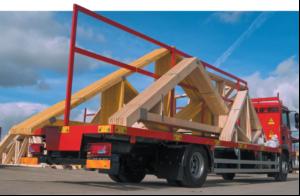Construction sites are typically extremely busy and it is
not uncommon for those working on them to be confused
over who is responsible for what. But everybody who
sets foot on a construction site should understand their
Construction sites are typically extremely busy and it is
not uncommon for those working on them to be confused
over who is responsible for what. But everybody who
sets foot on a construction site should understand their
health and safety responsibilities, even if they are only a
visitor, says the Trussed Rafter Association
The interface between suppliers
and contractors can be a grey area
and there is often confusion
about where the supplier's responsibility
ends and the contractor's begins. TRA
members are acutely aware of this, not
least, because their products tend to be
large and require specialist knowledge to
handle safely.
"While we always insist our members are
aware of site safety, the fact is that the
responsibility on site is almost entirely
down to the customer" explains Paul
Colley, chairman of the TRA (Trussed
Rafter Association) health and safety
committee. Despite this, some site
personnel taking delivery of a lorry load
of roof trusses will expect the delivery
driver to take responsibility for unloading.
In fact, it is the responsibility of the site
manager to provide a 'responsible' person
to ensure that materials delivered to site
are unloaded safely. "Once he arrives on
site, the driver releases the load as per his
Safe System of Work and at the
instruction of the 'responsible' person and
that's the extent of his responsibility"
explains Paul. "They are not slingers or
Banksmen, but they do know how the
load is attached to the vehicle and the
order in which components should be
unloaded," he says.
Standing in a safe position, the delivery
driver will release the ties securing the
trusses to the lorry bed at the instruction
of the 'responsible' person. This
competent person supervising the lift
should then instruct the driver where to
stand so he will not be in the way or at
risk of injury.
Ensuring pre-fitted slings are in the
right place is also the responsibility of the
customer. Manufacturers generally
identify the areas where slings or hooks
should be attached, yet the lifting
operation itself is the responsibility of the
site staff.
Transport is a different matter.
"Delivering trusses is not like delivering a
load of pallets" says Paul.
"Trusses are large and you seldom get
two the same. So you might have a lorry
carrying all sorts ranging from a 9.5m
truss weighing 350kg to a 1m truss
weighing only 25kg." he explains. "Plus,
you will probably be carrying some
additional timber plus ancillary
components as well."
Drivers are not expected to load or
unload these items but they must
understand and be happy with how they
are secured before accepting the load and
be able to make adjustments if the load
shifts during transport.
Look out for the CSCS card
Drivers should also carry a Construction
Skills Certification Scheme card even
though they usually have no specific
construction skills. All regular visitors to
building sites are now required to have
passed the Construction Skills health and
safety test and carry the appropriate CSCS
card to prove it.
"The contractor should ask to see the
driver's CSCS card when inducting the
driver but many still do not" says Paul.
The only respect in which
manufacturers can be said to be
responsible for site safety is under the
Construction (Design & Management)
regulations 2007. Here, the manufacturer
is liable if a design or manufacturing
defect causes an accident on site. But even
this is a grey area, says Paul
"Trusses are sometimes manufactured
to a design supplied by the client. If that
design is faulty and an accident results, is
the manufacturer responsible for not
noticing the fault and notifying the
client?" he asks.
Trussed rafters normally help improve
site safety, since their off-site manufacture
reduces site operations and the need to
work at height. However, a couple of
recent tragic incidents have focused
attention on the need for meticulous care
when transporting and handling trusses.
TRA remains vigilant and its members
adhere to a code of conduct. If everybody
in the supply chain understands their
responsibilities, site safety will continue to
improve.
For more information on the Trussed
Rafter Association, please visit:
www.tra.org.uk.


